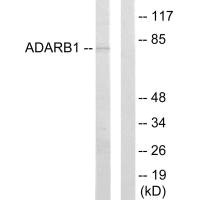
Western blot analysis of extracts from HepG2 cells, using ADARB1 antibody.
ADARB1 Antibody
CSB-PA949783
ApplicationsWestern Blot, ELISA
Product group Antibodies
ReactivityHuman, Mouse, Rat
TargetADARB1
Overview
- SupplierCusabio
- Product NameADARB1 Antibody
- Delivery Days Customer20
- ApplicationsWestern Blot, ELISA
- CertificationResearch Use Only
- ClonalityPolyclonal
- ConjugateUnconjugated
- Gene ID104
- Target nameADARB1
- Target descriptionadenosine deaminase RNA specific B1
- Target synonymsADAR2; adenosine deaminase, RNA-specific, B1 (homolog of rat RED1); double-stranded RNA-specific editase 1; DRABA2; DRADA2; dsRNA adenosine deaminase DRADA2; NEDHYMS; RED1; RNA editing deaminase 1; RNA-editing enzyme 1
- HostRabbit
- IsotypeIgG
- Protein IDP78563
- Protein NameDouble-stranded RNA-specific editase 1
- Scientific DescriptionCatalyzes the hydrolytic deamination of adenosine to inosine in double-stranded RNA (dsRNA) referred to as A-to-I RNA editing. This may affect gene expression and function in a number of ways that include mRNA translation by changing codons and hence the amino acid sequence of proteins; pre-mRNA splicing by altering splice site recognition sequences; RNA stability by changing sequences involved in nuclease recognition; genetic stability in the case of RNA virus genomes by changing sequences during viral RNA replication; and RNA structure-dependent activities such as microRNA production or targeting or protein-RNA interactions. Can edit both viral and cellular RNAs and can edit RNAs at multiple sites (hyper-editing) or at specific sites (site-specific editing). Its cellular RNA substrates include: bladder cancer-associated protein (BLCAP), neurotransmitter receptors for glutamate (GRIA2 and GRIK2) and serotonin (HTR2C), GABA receptor (GABRA3) and potassium voltage-gated channel (KCNA1). Site-specific RNA editing of transcripts encoding these proteins results in amino acid substitutions which consequently alter their functional activities. Edits GRIA2 at both the Q/R and R/G sites efficiently but converts the adenosine in hotspot1 much less efficiently. Can exert a proviral effect towards human immunodeficiency virus type 1 (HIV-1) and enhances its replication via both an editing-dependent and editing-independent mechanism. The former involves editing of adenosines in the 5UTR while the latter occurs via suppression of EIF2AK2/PKR activation and function. Can inhibit cell proliferation and migration and can stimulate exocytosis. Mittaz L., Genomics 41:210-217(1997). Lai F., Mol. Cell. Biol. 17:2413-2424(1997). Villard L., Somat. Cell Mol. Genet. 23:135-145(1997).
- ReactivityHuman, Mouse, Rat
- Storage Instruction-20°C or -80°C
- UNSPSC12352203
